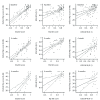Outcome assessment after hip fracture: is EQ-5D the answer?
- PMID: 24648420
- PMCID: PMC3963508
- DOI: 10.1302/2046-3758.33.2000250
Outcome assessment after hip fracture: is EQ-5D the answer?
Abstract
Objectives: To study the measurement properties of a joint specific patient reported outcome measure, a measure of capability and a general health-related quality of life (HRQOL) tool in a large cohort of patients with a hip fracture.
Methods: Responsiveness and associations between the Oxford Hip Score (a hip specific measure: OHS), ICEpop CAPability (a measure of capability in older people: ICECAP-O) and EuroQol EQ-5D (general health-related quality of life measure: EQ-5D) were assessed using data available from two large prospective studies. The three outcome measures were assessed concurrently at a number of fixed follow-up time-points in a consecutive sequence of patients, allowing direct assessment of change from baseline, inter-measure associations and validity using a range of statistical methods.
Results: ICECAP-O was not responsive to change. EQ-5D was responsive to change from baseline, with an estimated standardised effect size for the two datasets of 0.676 and 0.644 at six weeks and four weeks respectively; this was almost as responsive to change as OHS (1.14 at four weeks). EQ-5D correlated strongly with OHS; Pearson correlation coefficients were 0.74, 0.77 and 0.70 at baseline, four weeks and four months. EQ-5D is a moderately good predictor of death at 12 months following hip fracture. Furthermore, EQ-5D reported by proxies (relatives and carers) behaves similarly to self-reported scores.
Conclusions: Our findings suggest that a general HRQOL tool such as EQ-5D could be used to measure outcome for patients recovering from hip fracture, including those with cognitive impairment. Cite this article: Bone Joint Res 2014;3:69-75.
Keywords: EQ-5D; Oxford Hip Score; Fragility Fractures; Proximal Femur; ICECAP-O; Outcome assessment.
Conflict of interest statement
Figures



References
-
- Johnell O, Kanis JA. An estimate of the worldwide prevalence, mortality and disability associated with hip fracture. Osteoporos Int 2004;15:897–902 - PubMed
-
- No authors listed. National Hip Fracture Database National Report 2013. http://www.hqip.org.uk/assets/NCAPOP-Library/NCAPOP-2013-14/NHFD-Nationa... (date last accessed 20 January 2014).
-
- Appleby J. Patient reported outcome measures: how are we feeling today? BMJ 2011;344. - PubMed
-
- Fitzpatrick R. Patient-reported outcome measures and performance measurement. In: Smith PC, Mossialos E, Papanicolas I and Leatherman S. eds. Performance measurement for health system improvement: experiences, challenges and prospects Cambridge: Cambridge University Press, 2009: 63-86.
Grants and funding
LinkOut - more resources
Full Text Sources
Other Literature Sources

